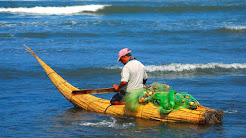I started a 50-week series in 2019 that I called Travel the World. Each week of the series I visited a randomly-selected country, sharing bits of information about that country. I then chose one tidbit of information about that week's country as inspiration for a card. As I explored those 50 countries in 2019, I knew I would continue on until I've visited every one of the 195 countries in the world. By the end of 2021, I'd virtually traveled to 145 countries and plan to complete my journey to all 195 countries by visiting the last 50 this year.
This week's country is...
Peru
Peru is in western South America, bordering the South Pacific Ocean, between Chile to the south and Ecuador to the north. It is also bordered in the north by Columbia, in the east by Brazil, and in the southeast by Bolivia.
Peru is slightly smaller than the state of Alaska in the USA - and almost twice the size of Texas. Peru is about twice the size of France.
Peru has a coastline of 1,500 miles.
Lima is the capital of Peru.
There are 43 languages spoken in Peru.
Peru is home to the oldest continuously working University in the Americas.
The Andean Condor, found in Peru, is the largest flying bird in the world. Interestingly, it can fly for 100 miles without flapping its wings.
Peru holds the world records for the maximum number of birds sighted in one place and the greatest number seen in a single day.
The Amazon Rainforest covers almost two-thirds of Peru.
The Amazon River begins in Peru.
One can swim with pink dolphins in Peru. These unique creatures only live in the Amazon River basin. When born, they are actually grey and slowly turn pink as they get older, which results in dolphins in all different shades of pink.
Three-fourths of the world's Alpaca population lives in Peru. With the total global population estimated at 10 million, that means there are more than 7.5 million Alpacas in Peru.
The Peruvian Inca Orchid is one of those dogs that is so ugly, it’s cute. It’s got a hairless, often spotted body then a tuft of white or grey hair on top of its head, making it look like a funny old man. This breed is often 20 inches in height, weighs about 20 pounds and lives upwards of 10 years. They are quite affordable at a cost of $500 for a puppy and are known to be affectionate and gentle. This is a breed that is more intelligent than most and is often used as an obedience, hunting or sighting dog.
Peru is the birthplace of the humble potato so it's not surprising there are more than 4,000 varieties found in the country.

At about 6,800 feet in elevation, Cerro Blanco is considered to be one of the world's highest sand dunes, if not the highest. It is located between the Pacific Coast and the Andes Mountains in one of the most arid regions on earth. Although it takes three to four hours to hike to the top of this massive sand pile, sandboarding (think snowboarding on sand) back to the base only takes about thirty minutes.
The deepest canyon in the world, Cotahuasi Canyon, is also found in Peru. At 11,004 feet deep, it is almost twice as deep as the Grand Canyon.
Salt farming in Peru is still done the same way as the Incas. What happens is subterranean salty water is let out into a patchwork of pools, where it then evaporates, leaving the salt behind. It’s a remarkable sight, like a yellow version of rice paddies, in a way. Each family has its own pool!
The main economic activities in Peru are mining, manufacturing, agriculture and fishing.
Among Peru's main exports are: copper, lead, since, iron ore, petroleum, natural gas, coffee, asparagus and fish products.
Peruvians celebrate New Year’s by gifting one another yellow underpants on New Year’s Eve to bring good luck in the coming year. It is tradition to wear them inside out (underneath clothing) until midnight, then flip them around at the stroke of midnight.
It takes between 500 and 600 hours and up to six months to spin, dye, and weave a traditional Peruvian poncho. Peruvians generally receive one poncho upon becoming an adult and it is expected to last a lifetime. Nearly every weaving technique known today was invented by Peruvians – and all of them were invented by 3000 B.C..
There is a lot of corn in Peru. It’s not just the yellow kind that you know and love. There is pink, black, purple, white, and orange – a multicolored spectrum of corn.
People live on Peru's Lake Titicaca (the world's highest navigable lake) on floating islands made of grass.
Peru is home to over 1,700 species of birds, over 500 species of mammals and over 300 species of reptiles. Of the 500 mammal species about 100 are threatened or endangered.
Among the endangered animals of Peru are the Andean bear, the pudu, the jaguar, also known as otorongo and the giant otter.
The vicuna is the national animal of Peru.
My inspiration for this week's card is based on this fact about Peru... There are penguins in Peru. These Humboldt penguins are found along the Pacific coast. The total world population of the Humboldt penguins is around 12,000 breeding pairs, with about 8,000 of the pairs in Chile and the other 4,000 pairs in Peru.
Thanks for stopping by my blog today!
Stamp/Punch Set: Stampin' UP Penguin Place stamped with VersaFine Clair Nocturne and Concord & 9th Marmalade Ink
Paper: Accent Opaque 120# White, Recollections Black, and SU Pool Party and Pumpkin Pie CS
Stencil/Ink: Circle Stencil (unknown vendor) and Concord & 9th Aqua Sky Ink
Dies: Pink Fresh Diagonal Stitched Rectangle
Embellishments: Taylored Expressions Drop Tiny Diamonds














.jpg)















No comments:
Post a Comment